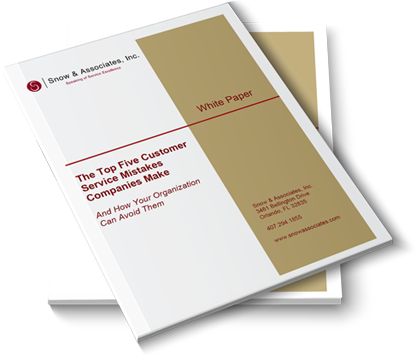
The Top Five Customer Service Mistakes That Companies Make
And How Your Organization Can Avoid Them.
Posted on April 5, 2021 by Dennis Snow
World-class organizations ALWAYS focus on retaining excellent employees. Even during this time of COVID. And while some of you have had to lay off or furlough employees, I’m sure you’d like your best people to want to come back when you ramp up your operation.
The Research
According to research by the Gallup organization, an employee’s direct boss has the greatest impact on retention. Gallup goes so far as to state, “Employees don’t leave companies, they leave bosses.”
Employee exit interviews show that a lack of recognition or sincere appreciation is one of the top reasons for quitting a company. Therefore, it makes sense that the most effective recognition comes from the employee's direct manager.
It's Not About a New Recognition Program
Organizations are always on the lookout for the magical reward or recognition program. One that will maximize employee performance. Formal recognition programs CAN be effective. But it’s important to know that a recognition program can NEVER take the place of a sincere thank you from the boss.
What Works
You want employees to exceed the expectations of your customers. So, it’s vital that you recognize them when they perform in a manner that exceeds expectations. You want employees to perform in a manner consistent with your service standards. So, it’s vital that you notice when they do so and recognize their performance.
There’s a very real phenomenon called “extinction.” This occurs when we ignore performance of a desired behavior. Let’s say you desire responsiveness from employees. And yet you ignore them when they demonstrate excellent responsiveness. The behavior will eventually become extinct. Performance will revert to previous levels (not necessarily bad, but not at the desired, higher level).
When to Recognize Your People
Recognition has its greatest impact when it takes place immediately after the behavior. When an employee does something special for a customer (external or internal), their emotions are elevated. They know they did something good. That’s the best time to recognize the employee. The immediacy dramatically increases the likelihood that the behavior will be repeated.
The more time that passes, the less impact the recognition will have (although it may still be appreciated). The point is, don’t lose the magic of the moment when it comes to recognizing performance.
Storytelling as a Recognition Tool
Another important aspect of recognition is storytelling. Storytelling has proved to be a valuable tool to “lock in” recognition. As a leader, if you have recognized an individual for excellent performance, tell the story at the next staff meeting. Really tell the story. Let everyone know what the person did and the impact it had.
Better yet, depending on the situation, let the employee tell the story. This not only makes the employee feel good, but it also allows his/her co-workers to join in the celebration. This type of storytelling helps perpetuate a commitment to service excellence.
The Root of Recognition
The word “recognition,” in fact, comes from the Latin, “to know again.” Effective recognition allows the employee to know again the feeling of performing at a high level or reaching a significant milestone.
Something to Think About
Is there someone in your operation who you should have recognized but didn’t? You know what to do.